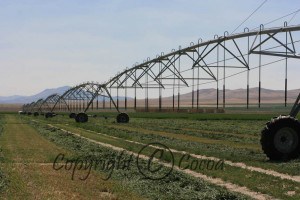I used to think farmers weren’t very smart. I even admitted this to Mr. Ferrero Rocher the first year we were married. I also acknowledged I was very wrong and naive. I had no idea all the things one needed to know to raise a good crop. Most of the things Mr. Ferrero Rocher, his brothers, and other farmers have learned have come from experience. It is not something you can learn in a classroom or from books. It’s definitely not a glamorous lifestyle, actually looked down upon by many, but we love it.
Mr. FR is in partnership with his father, 6 brothers, and a brother-in-law. We tease his parents that they must have done something wrong for all their children to want to stay on the farm, usually you hear of farmer’s children moving away from the the farm. There are two farms we own in separate towns. This one we are on is the larger of the two. We have 4 sections of land. Each section is one mile square or roughly 640 acres. We grow alfalfa hay that is sold to dairy farms in California.
The hay is irrigated using center pivot systems. See the white dot on the left of this photo? That is the center of the pivot. The rest of the pivot swings around in a circle, much like a pencil does with a math compass, sprinkling whatever crop happens to be planted.
 Center pivots were originally designed to operate on square quarter sections (160 acres) of land. They can now be customized for any acreage. We have a total of 13 full center pivots and two smaller pivots that are about half the size of the full ones. Right now all of our pivots are planted with alfalfa hay except for one which has triticale, a type of of crossbred grain from wheat and rye, that we are using as a rotation crop.
Center pivots were originally designed to operate on square quarter sections (160 acres) of land. They can now be customized for any acreage. We have a total of 13 full center pivots and two smaller pivots that are about half the size of the full ones. Right now all of our pivots are planted with alfalfa hay except for one which has triticale, a type of of crossbred grain from wheat and rye, that we are using as a rotation crop.
Alfalfa is much like grass in that it grows again after you cut it. We typically get four cuttings a year, though it looks like we will only get three this year because our spring weather was so cold it put us at least three weeks behind our normal summer schedule. A stand of alfalfa can last anywhere from 3 – 8 years depending on its productivity. When we decide a stand is no longer as profitable we will plant a rotation crop for a year to renew the soil and then plant new alfalfa. We usually rotate with either corn, wheat, or triticale.
Today is the last day of our first crop. HURRAY! The boys are out right now hauling the last two pivots that were baled early this morning. Each day this week I’ll talk about a different step in the process of putting up hay: swathing, raking, baling and hauling. I promised videos showing each one. I have dutifully taken the video and tried with all my might to get them on my computer last night. The instructions in the camcorder manual said I had to use a certain cable but my computer didn’t have the right port for it. I finally figured out a way to do it though so we are good to go!

This is great! I was going to ask what sounds like a really lame question but I’ll wait out the week and see if you answer it and I don’t have to show how ignorant I really am.
Having grown up on the concrete farm called Los Angeles, I find these kinds of posts fascinating. I love learning about the way things are done.
I just love living on a farm too. Those were really great pictures:)
I love this!!!
Thanks for the info, we love to read and see all about your farm!